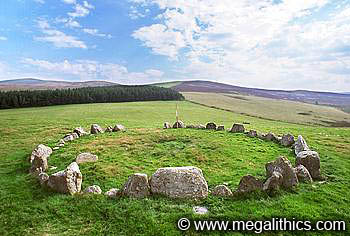More Pics
Panoramas
SJ 05612 37178 (GPS 56min)
Diameter 10.7 x 10.9m (Meas.)Visited August 2001
No magnetic anomalies.A very steep walk from the nearest road, this site is well worth the effort. With its location at the top of a hill, Moel ty Uchaf has stunning panoramic views over the valley below and the circle itself is also very attractive. Moel ty Uchaf "the High Bare Hill", is a cairn circle of contiguously set stones in a good state of preservation. The ring is broken at the SSE by what is assumed to be an original entrance, a second, shorter, interruption occurs at the east presumably be due to loss of stones.
We counted 41 stones in the ring and an extra stone inside the circle at the NE, the stones do not appear to be graded, and the largest stone sits exactly at the north. Burl describes a "finely preserved cist" at the centre of the ring, but all we could find was a circular depression with signs of recent digging. There is an outlying stone at the NNE, because of the steep slope of the hill this stone is considerably lower than the circle which appears silhouetted on the horizon from that location. The outlier has been levered out of its stonehole very recently, and now lies a couple of metres further down the hill. There does not seem to have been any digging in the hole, and we could see no reason for someone to displace this stone.
On the other side of the ring from the outlier is a shallow valley in which there is a low cairn SSE of the circle. This is so low, it is easy to miss, but when we visited, the covering vegetation showed a prominent "cropmark" colour change which made is stand out. The cairn is circular and has a depression at its centre, "much white quartz" is said to have been dug from it. About 40m east of the cairn is a jumble of large stones that made us wonder if they had once been another megalithic structure, now destroyed and its remnants piled here.


